Uncomfortable situations and conflict will occur at some point in time. This does not mean, however, that these situations cannot be managed and resolved. We can limit workplace conflicts by understanding the reasons why conflicts occur, identifying small conflicts or uncomfortable situations before they turn into bigger ones, anticipating conflict within our teams, and using proven techniques for resolving conflicts.
War for Talent
The term "war for talent" could be used to describe the current job market in Cambodia. There is a battle taking place for the best people that the country has to offer. Even the largest companies with the biggest budgets and attractive list of benefits are struggling to find and retain quality staff.
Cambodia has one of the fastest growing economies in the world over the last decade. With that growth, the demand for quality, experienced employees has increased significantly.
Growth in both the economy and employment
In Cambodia between 2011 and 2014, the number of people employed rose by a staggering 23.5%. In the same period, employment in construction rose by around 40%, finance and insurance employment rose approximately 38% (National Employment Agency, 2015). These are amazing growth rates considering most of the world is still struggling for any growth at all.
With that sort of growth in employment, you can expect shortages of talent at all levels. If you also factor in the challenges of an education system producing graduates that are not perceived as being "ready for work", the issue becomes even greater.
Impact of localisation
Adding to the talent shortage for senior level positions, there is also the trend of localising many senior positions. This has resulted in many experienced expats leaving the country, leaving a hole in the market, as there is not enough senior local talent to fill these roles. There are many talented locals capable of filling these roles, though not enough to meet growing demand. Companies entering the market are seeking local employees to fill roles previously filled by expats, and are frustrated by the lack of local senior talent. With the forces of supply and demand in a growing market, the challenge to find good people has never been more difficult.
Impact on business performance
The same NEA study revealed that the skills gaps and inability to recruit qualified people was impacting business performance.
- 61% reported delay in development of new products and services
- 48.4 % reported losing business or orders to competitors
- 43.4% reported difficulty meeting customer service levels
- 34.1% reported increased workload for current staff
- 29.4% reported difficulty meeting quality standards
Impact on salaries
The pressure of supply and demand will also result in growth of salary expectations for skilled people. I have had the discussion with some employers recently that "Just when I think we have our salary bands right, the market changes". This particularly becomes relevant in your retention strategies. If you are not regularly reviewing your salary structures, you can find that you are losing people to higher paid roles.
People strategy is key
An organisation is only as good as the quality of the employees. With talent becoming increasingly difficult to attract, every organisation should be developing their people strategies including recruitment, engagement, retention, training, compensation and benefits and succession planning. These activities should be considered just as important as any other part of the strategic plan. Human resource departments must become more strategic, more creative and more competitive in the way they attract, develop and retain their people.
HRINC Recruitment has spent 10 years developing a network and database of industry professionals. HRINC is the largest and longest running HR service provider in Cambodia. If you require assistance with you strategic planning, training or recruitment, HRINC can help.
Adrian LOW is a Managing Partner with HRINC Cambodia and Myanmar. Adrian has more than 20 years in Management, Marketing and Consulting positions in Human Resources, Recruitment and Training industries in Australia and South East Asia.
Practical Procedures for Employment Separation in Cambodia
Introduction: Separation is costly. What is a healthy turnover rate?
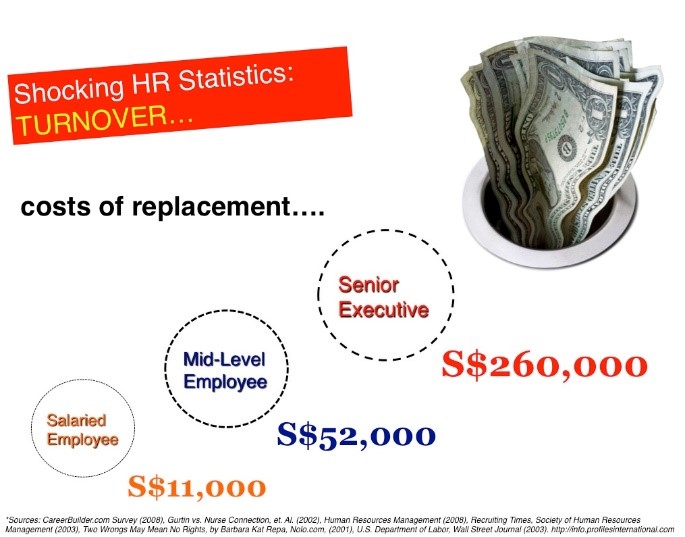 Retention is one of the biggest challenges that companies face today. Retention is measured by turnover and is calculated by the number of people leaving a company during a specified period of time by the average total workforce. Retaining employees or employee retention is an important HR measurement and gives insights into management and HR Practices of the company. Are policies effective, are management practices driving innovation and creativity of the workforce such that they are contributing and feeling valued by the company. Generally, any company wants to retain employees as long as possible, in other words, have a low turnover rate. But the question that comes is; “What is a healthy turnover rate?”
Retention is one of the biggest challenges that companies face today. Retention is measured by turnover and is calculated by the number of people leaving a company during a specified period of time by the average total workforce. Retaining employees or employee retention is an important HR measurement and gives insights into management and HR Practices of the company. Are policies effective, are management practices driving innovation and creativity of the workforce such that they are contributing and feeling valued by the company. Generally, any company wants to retain employees as long as possible, in other words, have a low turnover rate. But the question that comes is; “What is a healthy turnover rate?”
A company with a high retention rate (low turnover) will not benefit from innovation and new ideas and perspectives and new experience and talent. A company with a low retention rate (high turnover) means the company will not benefit from their investment in recruitment, training and development and management inputs and lose their internal know-how, intelligence and experience. When turnover is high, a vicious and expensive cycle of recruitment, induction, training starts and both internal as well as external relationships with customers may suffer. We can say in summary that companies need to prioritize employee planning from succession planning to training & development so that they retain talented employees and ensure they grow with the organisation. It is healthy to have some turnover and benefit from new and fresh perspectives. An employer always needs to think strategically about how to retain employees.
Based on the latest HRINC Annual Compensation Surveys conducted by HRINC Cambodia the average turnover rate amongst large companies in Cambodia is around 19 percent. The HRINC Annual Compensation survey also shows that Sales, Marketing and Operations are the top 3 functions that the companies face the highest turnover.
In the same survey, respondents were asked to describe the reasons why employees separate from the company. Separation is looked at from the employee as well as the employer perspective. Separation on the count of the employee occurs when the employee chooses to resign from the company for their own reasons discussed below. Separation on the count of the employer is generally considered to be termination of employment which can be for a variety of different factors discussed below.
Reasons why separation occurs? What is driving turnover?
Separation initiated by employees
The most common reason for the employee resigning according to employers in Cambodia’s is an offer of better salary and compensation elsewhere. Better compensation offered in particular by new and emerging sectors, such as financial services in Cambodia, remains a significant challenge in retaining employees and managing HR today. A variety of studies and efforts are made by employers to remain visionary, creative and innovative in compensation including studying the market rates for positions and participating in HRINC annual salary surveys, understanding the supply and demand of talent and other economic and social developments having an impact on compensation strategies and design. Compensation planning is still relatively new and technically a difficult subject for HR Professionals and require a rounded skills and knowledge set which include technical, business and economic know-how to influence top management in redesigning compensation strategies.
In real practice, companies don’t focus only on the money or cash provided. Other factors also require attention such as such as management leadership style, company culture, training development, authority & empowerment, working environment, non-monetary benefits and so on. These areas can also contribute to separation initiated by employees. HRINC clients regularly invest in engagement, satisfaction and organisation health surveys as a useful tool for the company to understand deeply about their challenges and opportunities and initiative creative strategies to address turnover and build world class organisation. An HR Audit is also increasing important to look at underlying compliance and HR practices and Management.
The figure below shows the most common reasons for an employee initiating separation with the company.
Figure 1: Reasons for the employee resigning, % of respondents
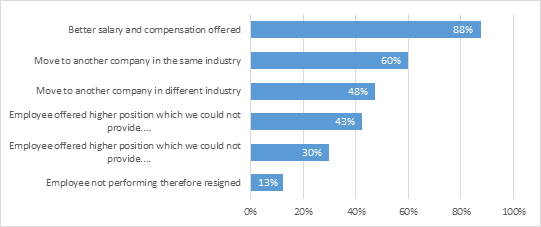
Source: HRINC Consulting Annual Compensation Surveys
Separation initiated by the company
In the event of business downturn where employer initiated separation can be considered to be “separation” due to downsizing or restructuring, most other types of company initiated separation are considered termination. The most common reason for the company terminating employment in Cambodia is poor performance, followed by gross misconduct and unprofessional & unethical behavior.
The emergence and high rate of termination due to gross misconduct and unprofessional and unethical behavior, stress the importance for companies to review their business and HR management practices. HRINC clients regularly review their HR practices in particularly by investing in an HRINC HR Audit which enables management to see not only “what” they have, but importantly “how” they are implementing policies and practices. Investing in skills and productivity development in all types of industries in Cambodia, will remain a top priority in medium term to long term.
The figure below shows the most common reasons for an employer to initiate separation; in other words, company termination of the employment contract.
Figure 2: Reasons for the company to terminate employment, % of respondents
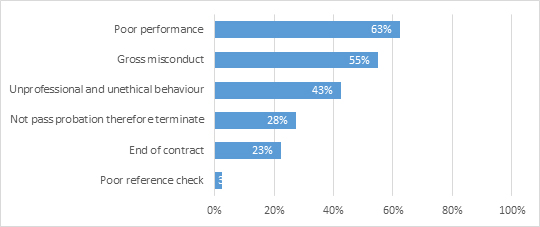
Source: HRINC Consulting Annual Compensation Surveys
Legal Procedures of Employment Separation and Termination in Cambodia
When we talk about separation of employment in Cambodia, it can be initiated by both the employee and employer.
First, we need to be clear on the type of contract that the company uses or that the employee is contracted by. In the Cambodia Labor Law, there are two types of employment contracts: First, a Specific Duration Contract (maximum of 2 years) or referred to as FDC and second, an Unspecific Duration Contract or referred to as UDC. The legal termination procedure for each type of employment contract carries with it different legal and compliance responsibilities which we will discuss below.
The Specific Duration Contract
For Specific Duration Contract, there are two types of termination that can occur. The first is: termination of employment on the specified expiry date and second, termination before the specified expiry date of the contract.
- In case of termination of employment by expiry (neither employer nor employee terminate the finish contract), the labor law requires the company to follow the following procedure:
- Provide notice as to the ending of the contract in line with the law. This is specified in Table 1.
- At the termination date, the employer is required to make the following end of contract payments:
- Pay last unpaid wages plus
- Compensation for unused annual leave and other benefits plus
- Severance pay (equal to the stated amount in Collective Bargaining Agreement or at least equal to 5% of total wages including bonus and overtime as well as other benefits (gross) that the employee has received during the period of the contract.
Length of Employment: FDC Notice Period Less than of equal 6 months 0 day More than 6 months to 1 year 10 days More than 1 year 15 days Note: if the notice period is not provided, the contract is extended for a length of time equal to its initial duration or redefined as a contract of unspecified duration if its total length exceeds the limit allowed in article 67 - In case of termination of employment before expiry (before the contract is finished), the labor law requires the company to follow the procedure below:
- If the employer terminates the employee before the contract was finished, they need to give prior notice the same as the table above, Table 1. And the employer need to pay last unpaid wages plus compensation for unused annual leave and other benefits and plus severance pay up until the last date of work. Moreover, employer needs to pay compensation that the worker should have received until the end of the contract as well as to pay compensation for prior notice.
- If the employee resigns before the contract was finished, the prior notice is the same as the table above but the employers can claimed for compensation equal to the damage to the damage they suffered from this termination. In reality this is not very easy to do in practice.
The Unspecified Duration Contract
For Unspecific Duration Contracts, there are also two types of termination of the contract: these are termination by the employer or by the employee.
- In case of termination of the unspecific duration contract by employer, the labor law requires the company to follow the procedure below
- The employer gives prior notice according to the law – see Table 2.
- The employer pays last unpaid wages plus compensation for unused annual leave and other benefits plus indemnity.
- For indemnity, it is equal to 7 days of wages and fringe benefits if the employee has worked in the enterprise form 6 to 10 months consecutively and to 15 days of wages and fringe benefits if the employee has worked in the enterprise for longer than 1 year. Time fractions of a year of 6 months or more shall be count as an entire year. The maximum of indemnity could not exceed 6 months of wage and fringe benefits.
Table 2: Notice period for Unspecified Duration Contract in Cambodia
Length of Employment: UDC Notice Period Less than of equal 6 months 7 days More than 6 months to 2 years 15 days More than 2 years to 5 years 1 month More than 5 year to 10 years 2 months More than 10 years 3 months - In case of In case of termination of the unspecific duration contract by employee, the labor law requires the company to follow the procedure below:
- Employee must give prior notice the same as the table 2.
- The employer pays last unpaid wages plus compensation for unused annual leave and other benefits.
Concluding thoughts
Separation, termination and turnover are costly processes to go through – not only financially but emotionally for teams, management and the entire organisation. It is important that HR professionals design policies and systems that mitigate the need for termination by understanding clearly why termination or separation happens. If there is a frequency with which “professional conduct or unethical behavior occurs”, company HR and operational policies need to be designed, to mitigate the ease with which such incidences occurred. It is important to remember that management approach and company policies can contribute to bad behaviors and practices if they are not well articulated, introduced to employees or enforced. It is important for HR managers to understand clearly, why termination or separation is occurring.
This article was written by Ms. SES Socheata, Head of Myanmar Operations and Compliance Services at HRINC and Mrs. NIL Keorachana, Senior Associate Consultant at HRINC Cambodia.
This article is not considered legal advice and employers or business owners pursuing a separation process should seek legal advice.
 This article was published in the Phnom Penh Post in 2009. At the time, we received an overwhelming response from employers, managers and young professionals in the market as to this “new concept” we were writing about. There was much disagreement that subordinates need to manage their manager as that is the primary responsibility of the manager to manage. Subordinates need to follow directions and do the jobs that manager’s request.
This article was published in the Phnom Penh Post in 2009. At the time, we received an overwhelming response from employers, managers and young professionals in the market as to this “new concept” we were writing about. There was much disagreement that subordinates need to manage their manager as that is the primary responsibility of the manager to manage. Subordinates need to follow directions and do the jobs that manager’s request.
We are republishing the article with a few additional edits as “Managing your Manager” is one of the most pertinent behaviours today that employers and managers’ seek in their employees and that business needs to succeed. In a world of so much information access and new technology, a very fast paced environment, “Managing your Manager” is more important today, than it ever was for young people to succeed in a competitive professional environment and for companies to manage risk.
Managers need to listen closely to their employees, today more than ever. It is the power of knowledge, employee perceptions and realities of business operations that our employees know better than we do as managers. A manager’s success is that of their employees. Our ability as managers to listen to feedback and inputs we get from our teams and integrate that into strategic thinking and business strategy, is how managers ultimately can coach and lead for success. Employee feedback is how our businesses’ innovate and succeed today and how we mitigate risks in daily operations.
“Who is the manager if I must manage my manager!?”
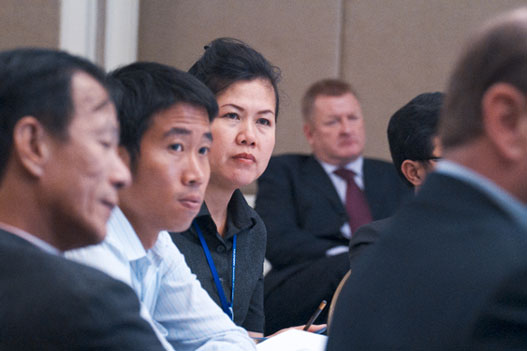 Surprising as it sounds managing your manager whether it be your supervisor, manager, or managing director is something we do every day! We are all managing our time, projects, family priorities, personal challenges and tasks constantly. In reality, every one of us is a manager! Managing your manager is the first step to becoming a successful well rounded professional in the future and achieving your career goals.
Surprising as it sounds managing your manager whether it be your supervisor, manager, or managing director is something we do every day! We are all managing our time, projects, family priorities, personal challenges and tasks constantly. In reality, every one of us is a manager! Managing your manager is the first step to becoming a successful well rounded professional in the future and achieving your career goals.
Our environment today is global, fast paced, extremely dynamic. We want more as professionals, companies want more from their employees, competition keeps pushing our limits, innovation is essential to success. Everything keeps changing and we feel a lot of different pressures than perhaps we had in 2009! To maintain a successful work-life balance, there is no escaping managing your manager. If employees do not effectively manage upwards, set expectations and communicate in a timely manner, our work life will not only become stressful, we will suffer disappointments and stressful situations, which can easily be avoided. Managing your manager is all about managing your managers’ expectations, managing and planning your work and communicating effectively to ensure that you are the most effective, efficient and creative in doing your job. Here are some tips and tricks to help you manage your manager effectively!
Keep your manager up to date.
Often managers are frustrated that they have to keep following up all the time on many different things. “Did you do this, did you do that, why are you late!” We have all heard those words from our manager. In an effective work environment, your manager should never follow up on your tasks, but you should follow up with your manager as to your progress and challenges you face!
How to do this? Send your manager regular updates on what you are doing and how it is going – this could be done every week, or every two weeks depending on your work load. Discuss with your manager how he or she wants to be updated. Before the deadline of any task, you should be giving your manager the results of your projects not waiting for your manager to ask for them.
Communicate your challenges with possible solutions
Communicating a challenge does not mean you cannot do your task, it means, you are managing expectations and your work effectively. It is not a good thing if you reach a deadline and say “but I could not because ….” Don’t wait until the last minute to inform your manager of challenges – it’s too late!
How to do this? Tell your manager immediately if you are unable to do something and importantly, make a recommendation and give ideas of what you think you can do to overcome the challenge! Don’t say “I can’t do this …” rather say, “I have tried all these things, but this is what has happened. I suggest we try a, b, c. I would like your inputs to continue with my task.”
Discuss your ideas with your manager and find a solution together. Always provide a solution to a challenge, don’t just bring the challenge or problem to your manager! Demonstrating your thinking and solutions shows your manager that you are creative, business minded and ready to go to the next level. Don’t be disheartened if your ideas are not used, learn from manager why a particular solution was chosen so that you understand why and can develop your thinking and knowledge.
Keep your manager informed of your competing priorities – Be realistic.
 Sometimes, we have too many things to do! It does not help to say, my manager gives me too much work to do. We must discuss and keep our manager and team members informed of all the tasks we need to do – especially if you have more than one manager or reporting line.
Sometimes, we have too many things to do! It does not help to say, my manager gives me too much work to do. We must discuss and keep our manager and team members informed of all the tasks we need to do – especially if you have more than one manager or reporting line.
How to do this? Try and have regular meetings with your manager and your team. Make sure that “Work Load – Who is doing what?” is on the agenda so that you are aware of all the things your team and manager are doing. Discuss when you have too many deadlines and need support. Very often, there is someone in the team who will be able to give some support! If there is no time for a meeting, try have a 5 minute discussion during the day or send an email. Remember that if you don’t communicate, then you cannot complain!
Ask for information & plan in advance
Sometimes managers assume you know something but you don’t! At HRINC we always say, “Don’t assume. Ask and know!” It is important that you ask questions about what you are doing and why. What are the objectives, deadlines, risks we will face, etc.? Managers are busy people and it is not an excuse to say – “But my manager is busy!” You have colleagues and other team members that can give you information and ideas. If you don’t ask, you won’t know and you will never be able to be proactive and anticipate.
Plan your work in advance, and plan on regular update meetings with your manager so that you can be effective in your job and get the required inputs from your manager you need. Regular updates doesn’t mean daily updates! Depending on your projects and tasks, perhaps a weekly or monthly update is sufficient.
You can always send an email to update your manager on progress and challenges you face. Managers don’t always respond to updates, but they read updates and appreciate knowing what is going on. If you have an important question that can answered on email – highlight the question in a different colour and bold it so that it stands out in the email.
Remember that too much communication can be overwhelming, be smart and thoughtful in your communication and choice of communication – speaking to people is much better than writing an email. Confirm your understanding in an email always on important matters, so that it is documented. Always remember to put a clear subject line in your emails if you are sending emails and set clear meeting objectives if you request a meeting with the necessary information your manager will need, to make decisions and be effective in the meeting.
Be proactive and anticipate
A challenge for managers is that often their team only does what they are told and nothing more. It is important that employees are proactive and anticipate challenges, different opportunities, and ideas.
How to do this? Think about what you are doing and how it will impact other processes and projects that are taking place in the office or your business unit. Remember that you cannot be proactive and anticipate, if you never asked any questions! Take an interest in other projects going on in the office. Take an interest in reading the news and keeping abreast economic changes. Take an interest in understanding what others in your team are doing. Connect the dots.
If you have identified an opportunity or a challenge that will impact your task – communicate them to your manager. Don’t wait too long, especially if you feel what you have identified, could have a big impact on your work – whether or not that impact is positive or negative!
Summary
The few golden rules are all about communication and being aware of how your job and tasks (no matter how big or small) are an important part of the success of your company or organisation! Remember, you see things differently from where you are sitting. Your manager sees things different from where they are sitting. Combining the two perspectives are what makes and incredibly dynamic and innovative organisation that succeeds and grows.
We must all manage upwards and manager our manager. A CEO to a board, a manager to a CEO, staff to a manager, worker to supervisor. If you try a few of the suggestions, you will see that your work will run smoother, you may have less stress and most importantly, you will feel that the work you are doing is really contributing and having an impact on how your company is growing. And the most important thing you feel, is a sense of accomplishment at the end of the day and wake up feeling refreshed and ready for a new opportunity and challenge. You will know that you are making a difference to the people and the place where you work.
Remember that practice makes perfect and you cannot do what the article says and expect things to change – how you manage, plan, prioritise and communicate needs to become a habit and an integral part of the way you work, so that you can climb the career ladder and achieve your professional goals.
This article was written by Sandra D’Amico, Managing Director of HRINC. It was published in the Phnom Penh Post in January 2009 and updated in August 2015.
“A job isn’t just a job, it consumes more than a third of your day – make sure you enjoy what you do and challenge yourself to be creative and do things differently!” Contact This email address is being protected from spambots. You need JavaScript enabled to view it. for more information
“I always prefer to believe in the best of people, it saves me so much time!"
Rudyard Kipling
A much shortened version of this article appeared in the Phnom Penh Post in early 2009. Since then, we have done a lot of “conflict management” and “managing difficult conversations” training. Over the years, with successful growth and expansion of our business, we have had to deal with resolution of conflict and uncomfortable interactions in the workplace – not only in one location, but across provinces and beyond borders. Whether a difference of opinion amongst management or a team dispute, what we have learned from conflict is that, if managed effectively and we take a step back and listen, conflict brings out the best each one of us as individuals and a team.
Today, we are elaborating on “Resolving conflict and uncomfortable interactions at work”. At HRINC we know, that the challenges we face as a growing SME are very often challenges that our clients and extended network of young and seasoned professionals face, every day.
We can all recall an uncomfortable interaction or situation at work – with a colleague, a subordinate or manager and even within our teams. As managers, we have experienced that strange silence in the room, where everyone looks down! Or, someone has finally had enough and just lets it all out making a manager look bad, or a team member crumble. In the worst case scenarios – an employee resigns as they have had enough.
Uncomfortable interactions at work can be healthy, surprising as that may sound, if they are managed effectively, and you are able to harness the power of differences in opinion and approaches. But in extreme cases, uncomfortable interactions become conflict and can be very stressful for everyone involved. Conflict results in poor staff morale, high staff turnover, low productivity, and lack of innovation.
“Ultimately, in all spheres of life, we don’t need to be best friends with everyone. What we do need to do is learn to foster and build exceptional professional relationships and networks, and learn that diversity and differences of opinion and way of working, are what makes companies great!”
HRINC Managing Director
It is important to be able to deal with uncomfortable situations and conflict effectively, as the rewards and outcomes are greater sometimes than we know. What can we say at HRINC these rewards and outcomes are from effectively managing an uncomfortable situation or conflict?
- We create productive relationships that learn to leverage the strengths of each other
- We enable team members to respect each other and their views and see that everyone contributes to success
- We propel success and innovation by identifying real issues, by removing the personal dislike or attack
- We create productive and constructive workplace relationships where we leverage the strengths, skills and knowledge of each other.
- We create cohesive and constructive teams who use conflicting ideas and approaches to their advantage and by so doing they work towards and achieve the best outcomes for the client and company; and finally,As managers and leaders, we have over time learned to deal with tougher situations with a greater sense of confidence and appreciation that we are a facilitators, leveraging the best out of people and leading them to great accomplishments.
All that said, we know that dealing with uncomfortable situations and conflict is not easy. Like an art, it takes time and experience to master the skills and know when to intervene or seek help. It takes patience, courage and confidence, to not doubt oneself and keep going in the face of a conflict. And today, we continue to learn and manage uncomfortable situations and conflict because it is something that is inherent to the diversity of our workplaces.
Causes of Conflict at Work
From Conflict to Change Management
Finally, it is worth remembering that in any workplace conflict, there are no real winners if you don’t take actives steps to managing the conflict.
Your attitude to resolving the conflict is most important. Whether you are trying to resolve conflict or are a part of the conflict, start out by agreeing that there is a particular situation that needs to be addressed. You can start out with agreeing to disagree on differing views, but try to get the best of the conflict, not win. You will see that conflicts can often turn into constructive debates with powerful results in which everyone does come out better for it, with a higher appreciation for diversity and respect for personal and professional differences.
“Ultimately, in all spheres of life, we don’t need to be best friends with everyone. What we do need to do, is learn to foster and build exceptional professional relationships and networks, and learn that diversity and differences of opinion and way of working, are what makes companies great.”
This article was written by Sean Power and Sandra D’Amico and published in the Phnom Penh Post in 2009. It was updated in 2015 Sandra D’Amico, Managing Director of HRINC.
A job isn’t just a job, it consumes more than a third of your day – make sure you enjoy what you do and challenge yourself to be creative and do things differently!
Contact This email address is being protected from spambots. You need JavaScript enabled to view it. for more information
A degree is not enough. This is a topic that the team at HRINC has been delivering to university students in a series of forums in Cambodia, though the message is relevant to university graduates throughout the region.
In a study published by the National Employment Agency in Cambodia in 2015, it was found that 4 out of the top 5 skills and competencies lacking among first time job seekers leaving Higher Education had little to do with their field of study.
The top 5 listed were:
- Lack of working world / life experience and maturity
- Technical or job specific skills
- Poor attitude / personality or lack of motivation
- Foreign language skills
- Communication skills
This is bad news for those people that have spent years studying to get good grades and focusing only on the technical skills and knowledge required for their studies.
To make the transition from student to employee, there is a far greater skill set required than just the knowledge you learn at university. An example of this is when an average student with strong English language skills is more likely to be hired by an international company than a top student with limited English language skills. Without effective communication there is little chance of success.
If you are simply studying for the knowledge, then study should be your focus. If you are like most people, and the purpose of studying at university to get a good job, then there are some other skills you should develop to ensure you are better prepared for the workforce.
Focus on these skills and competencies:
1. Try your best to get internships, part-time work or even full-time work (ideally in your field of study) during your study. It may impact your grades, though it will give you valuable experience in the workplace environment, exposing you to realities of the workplace and preparing you to take the next step in your career after graduation.
2. Improve foreign language skills: As mentioned previously, language skills can be a vital skill in gaining employment. Focus heavily on language skills through your study. Many interviews for professional jobs are in English. Many companies require strong English or other language skills. Even if you are a top student, without the ability to communicate and interview well, then you will not have the opportunities that others will have.
3. Read about, or attend courses on how to improve motivation and create a positive attitude. Employers are seeking those that are able to solve problems, focus on achieving a results, and are realistic in their expectations.
4. Participate in group or project activities throughout your study. These activities can help you develop your team work, communication and leadership skills.
5. Be realistic about your career path and show maturity. Be prepared to work your way up. Just because you have studied management, this does not make you a manager. Employers want employees that understand they have to work hard to prove themselves. The employee / employer relationship should be a win-win situation. Be prepared to give before you receive.
With the number of graduates and competition for the best jobs increasing, it is important that you make every effort to give yourself the edge over the other graduates by gaining the skills and experience that employers are seeking.
To encourage yourself to make the extra effort to gain the skills and experience listed, answer this question.
Why am I really studying?
- to get a degree
- to get a job
Get the skills that will give you the advantage over the thousands of students you will be competing with when you graduate.

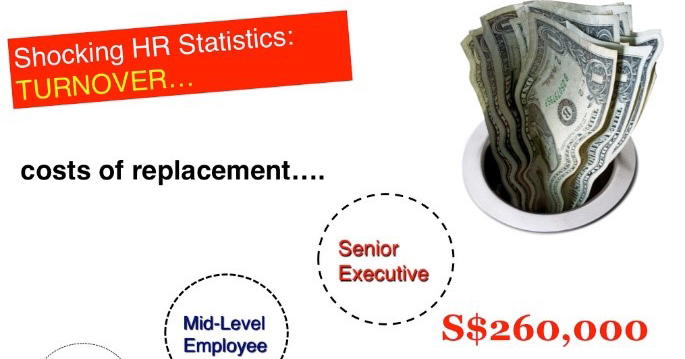


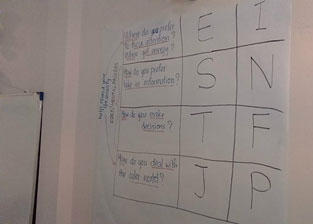 The power of the differences in the HRINC office, are exactly what makes us innovative and drives us every day. Different situations require us all to behave differently. As Managing Director, I know that I have had to change the way I work and engage. We have managed over the years to address small uncomfortable situations to having more serious and formal “management interventions” to deal with our different views and perspectives and will continue to leverage the differences and conflicting perspectives positively. It’s an ongoing process that evolves as we evolve as a business. My team, more often than not, has a critical view on a decision or the business which I have not seen or thought about and this enables us as a Group, to grow, expand and innovate. It enables me, to remain focussed on the priorities.
The power of the differences in the HRINC office, are exactly what makes us innovative and drives us every day. Different situations require us all to behave differently. As Managing Director, I know that I have had to change the way I work and engage. We have managed over the years to address small uncomfortable situations to having more serious and formal “management interventions” to deal with our different views and perspectives and will continue to leverage the differences and conflicting perspectives positively. It’s an ongoing process that evolves as we evolve as a business. My team, more often than not, has a critical view on a decision or the business which I have not seen or thought about and this enables us as a Group, to grow, expand and innovate. It enables me, to remain focussed on the priorities. There are several things that organisations can do to avoid conflicts arising in the first place. A good start is to have clear procedures in place for things like recruitment, promotion and performance evaluation and conflict management. Policies on sexual harassment, professional conduct and appropriate use of email will ensure that everyone knows what is expected of them. In addition,
There are several things that organisations can do to avoid conflicts arising in the first place. A good start is to have clear procedures in place for things like recruitment, promotion and performance evaluation and conflict management. Policies on sexual harassment, professional conduct and appropriate use of email will ensure that everyone knows what is expected of them. In addition,  Managers and employees should also look for ways to encourage team bonding, improve staff morale and create a constructive feedback environment. Regular lunches or social activities can help people get to know each other at a personal level. Good communication across all levels of an organisation can also help to prevent misunderstandings and encourage a unity of purpose.
Managers and employees should also look for ways to encourage team bonding, improve staff morale and create a constructive feedback environment. Regular lunches or social activities can help people get to know each other at a personal level. Good communication across all levels of an organisation can also help to prevent misunderstandings and encourage a unity of purpose.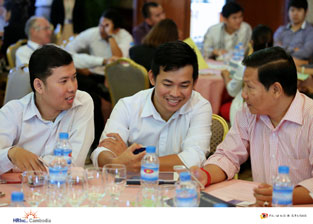 As a manger trying to resolve conflict, it is important to ensure that your role is to listen to all points of views and be objective. You are not there to “win the argument” and get the team to agree with you and what you want to happen. Individuals involved in the conflict should not be trying to “win the argument” either. Getting people to understand each other, is what needs to be done.
As a manger trying to resolve conflict, it is important to ensure that your role is to listen to all points of views and be objective. You are not there to “win the argument” and get the team to agree with you and what you want to happen. Individuals involved in the conflict should not be trying to “win the argument” either. Getting people to understand each other, is what needs to be done.